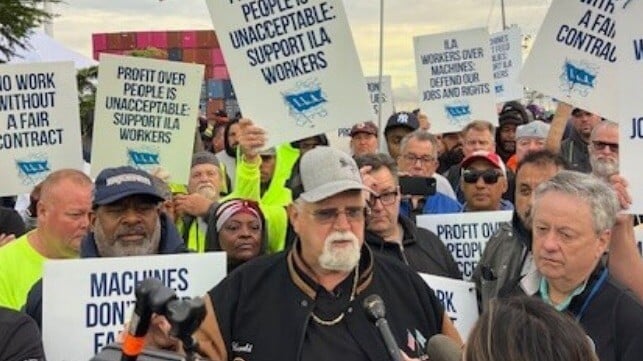East Coast Longshore Contract Talks Break Down Over Automation

After promising not to negotiate their new master contract in the media, the International Longshoremen’s Association and the United States Maritime Alliance issued statements arguing their position on semi-automation technology for U.S. ports along the East and Gulf Coast. The ILA said the talks are at “a crossroads with ocean carriers and employers,” reporting an impasse over the use of semi-automated rail-mounted gantry cranes (RMGs).
The ILA and USMX representing terminal operators and ocean carriers ended a three-day strike in October 2024 by agreeing to extend the contract expiration to January 15, 2025. It was designed to give them time to resolve the issues around automation and technology in the ports as well as other topics. After four scheduled days of negotiations, the ILA contends that USMX introduced new semi-automation mid-way through the talks, “causing the talks to break down.”
“USMX-ILA negotiations ended when management introduced their intent to implement semi-automation – a direct contradiction to their opening statement where they assured the ILA that neither full nor semi-automation would be on the table,” said ILA President Harold Daggett.
He said the stalemate over automation and semi-automation threatens to cause another strike in less than six weeks. “Our ILA members are ready to make the ultimate sacrifice to win this battle against automation,” said Daggett. “They understand it’s a fight for their very survival.”
USMX responded saying it is not seeking to eliminate jobs but that U.S. East and Gulf Coast ports need to be made more efficient. They point out that most of the ports lack land to expand saying that to meet demand and handle more volume the only way is “to densify terminals – enable the movement of more cargo through their existing footprint.”
The operators are arguing for what they are calling modernization and investment in new technologies. They say port operations must evolve. USMX highlights that the port that introduced RMGs a decade ago nearly doubled its volume after adding the technology.
“Our priority has been, and continues to be, using technology to improve our efficiency, safety, capacity, and productivity. We cannot risk moving the industry backward with unworkable restrictions on the implementation of modern technology already in use – and permitted by the existing contract – which would serve only to decrease efficiencies at ports, reduce existing capacity, prevent increased cargo volumes and throughput, and block further growth in union jobs and wages. We need to ensure we are strengthening an increasingly complex supply chain and supporting port resilience to weather disruptions or surges in trade volumes, so that we are facilitating robust growth across the U.S. economy,” USMX writes in a prepared statement.
ILA Executive Vice President Dennis Dagget wrote in a long statement, “The ILA is not against progress, innovation, or modernization, but we cannot support technology that jeopardizes jobs, threatens national security, and puts the future of the workforce at risk.”
He contends that 95 percent of the work performed by RMGs is fully automated with humans only involved in the last six feet of the container move when it is placed on a truck chassis. He attempts to extend the issue to “national security and economy.” He points to vulnerabilities and the potential to hack port systems raising the hypothetical of foreign adversaries such as China.
With the union using words such as “stalemate,” and “impasse” it is unclear what the next steps might be for the talks. A strike would come a week before the end of the Biden administration which pushed the employers to meet the ILA’s wage demands and the inauguration of Donald Trump. The ILA has said that Trump supports the union but a strike could be devastating to the U.S. supply chain and economy at the start of the new administration.
